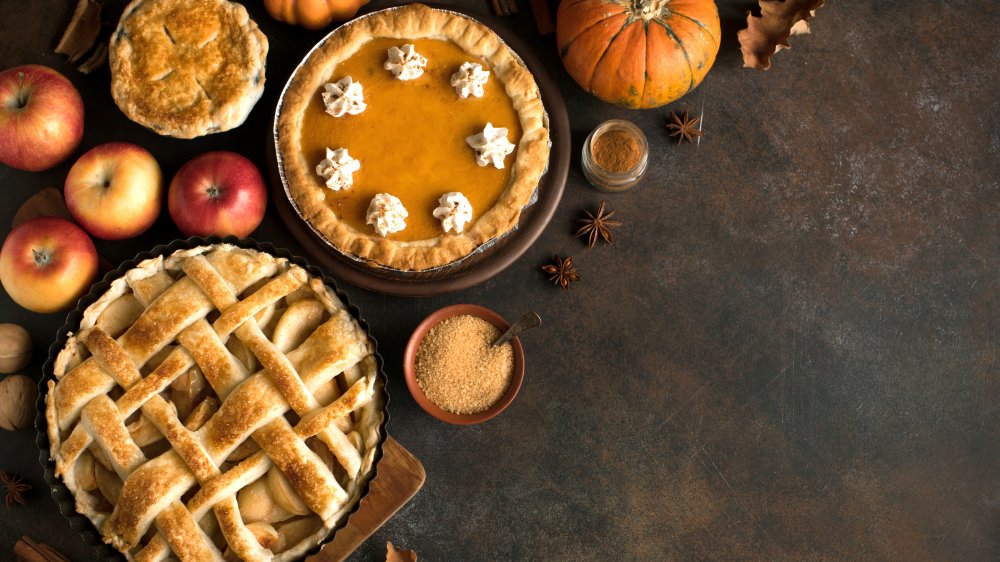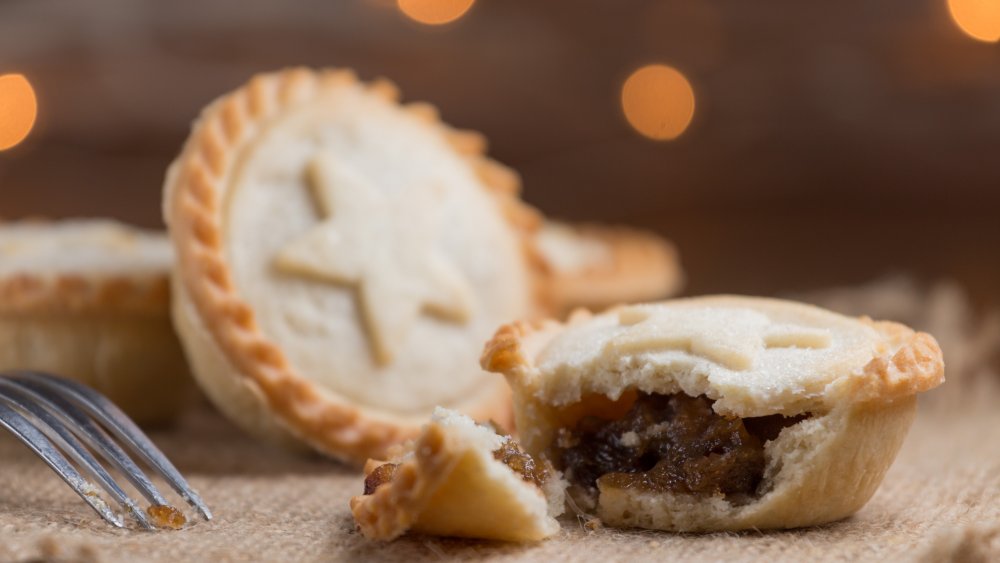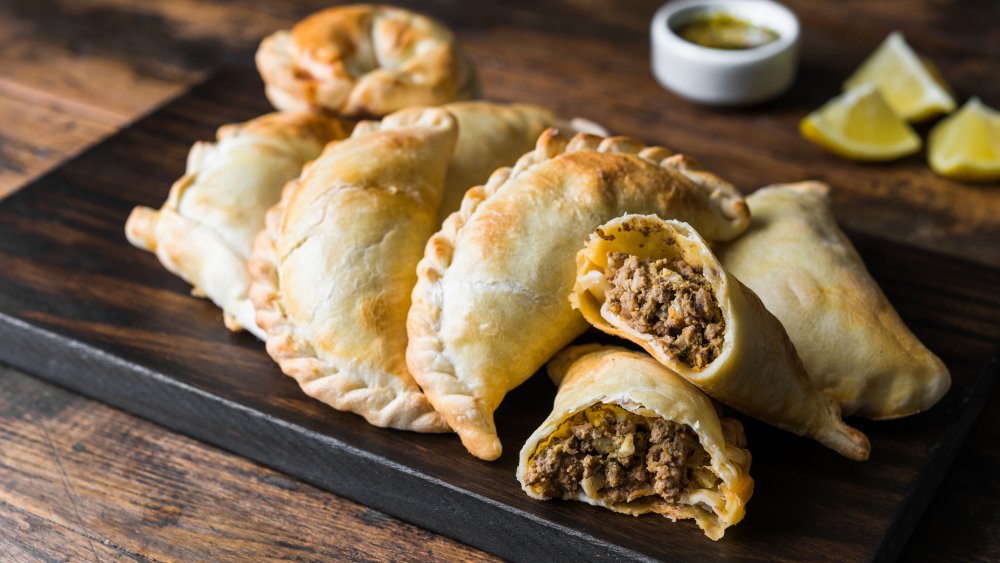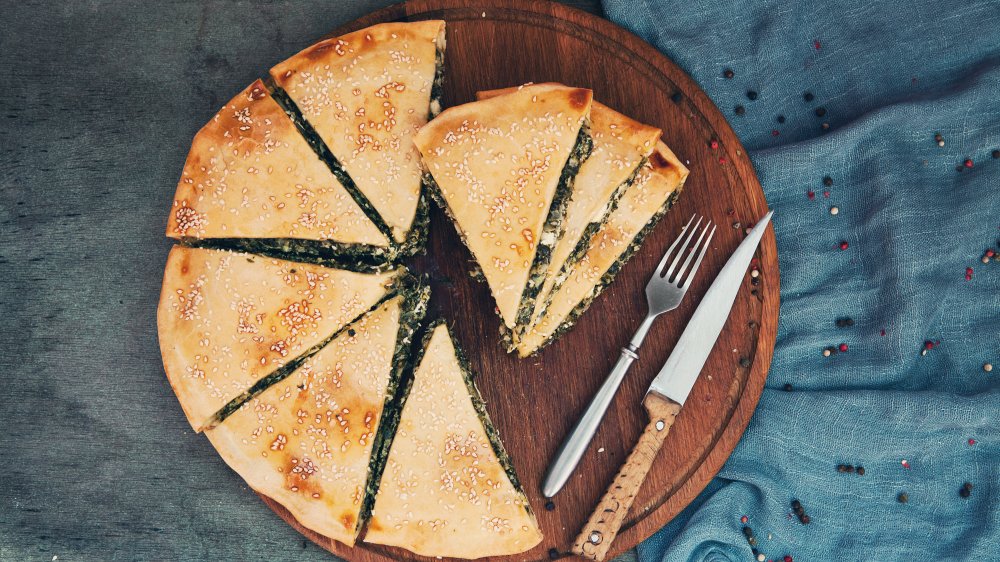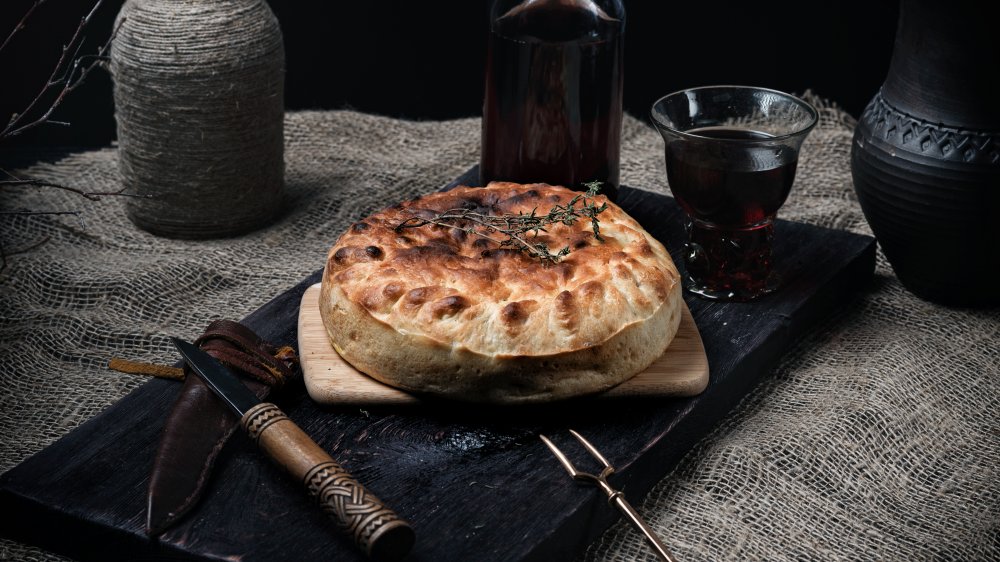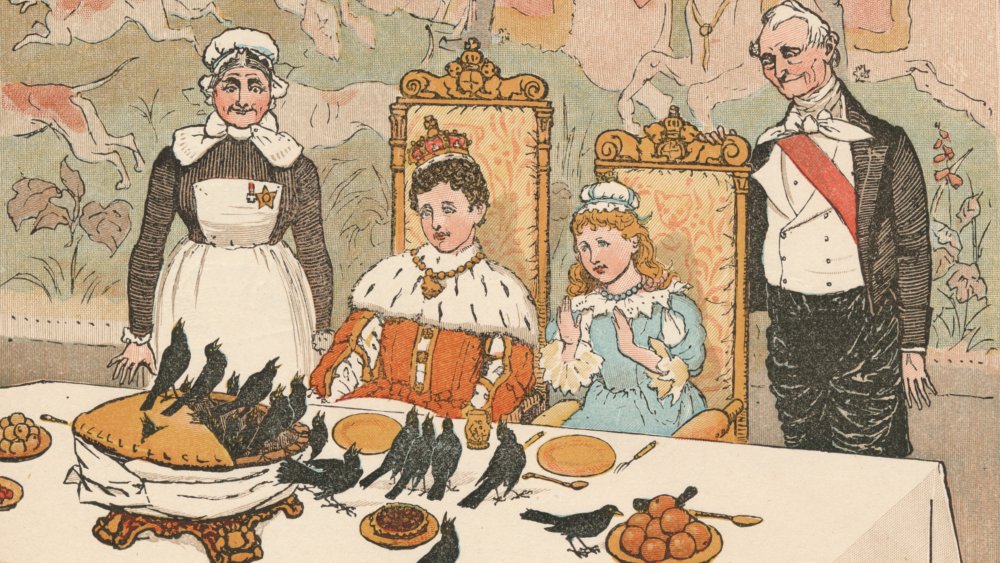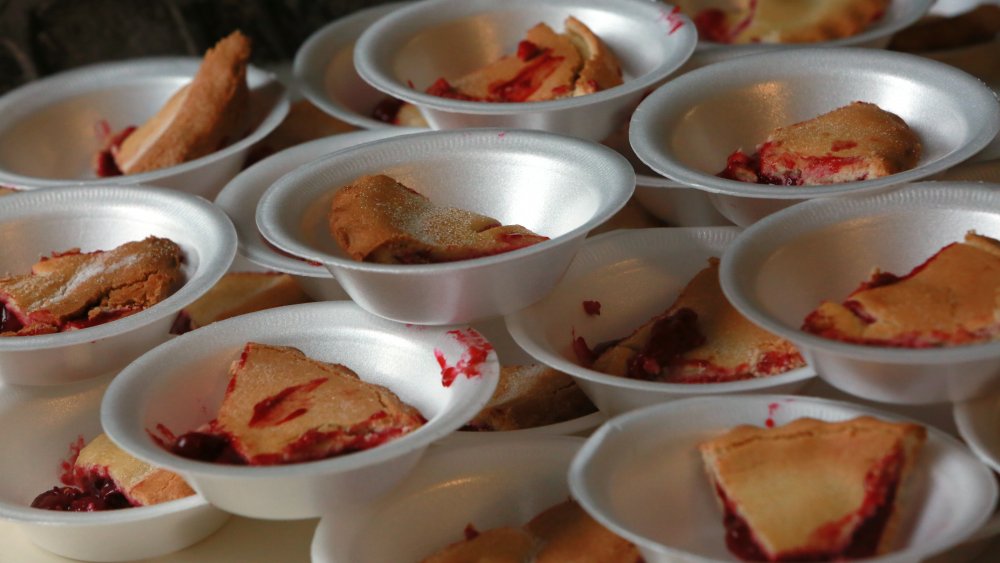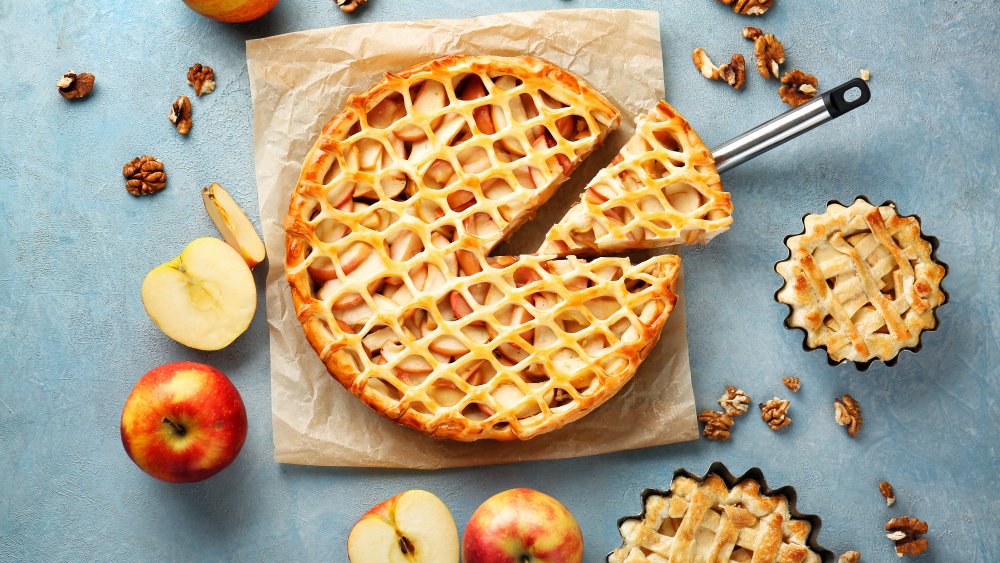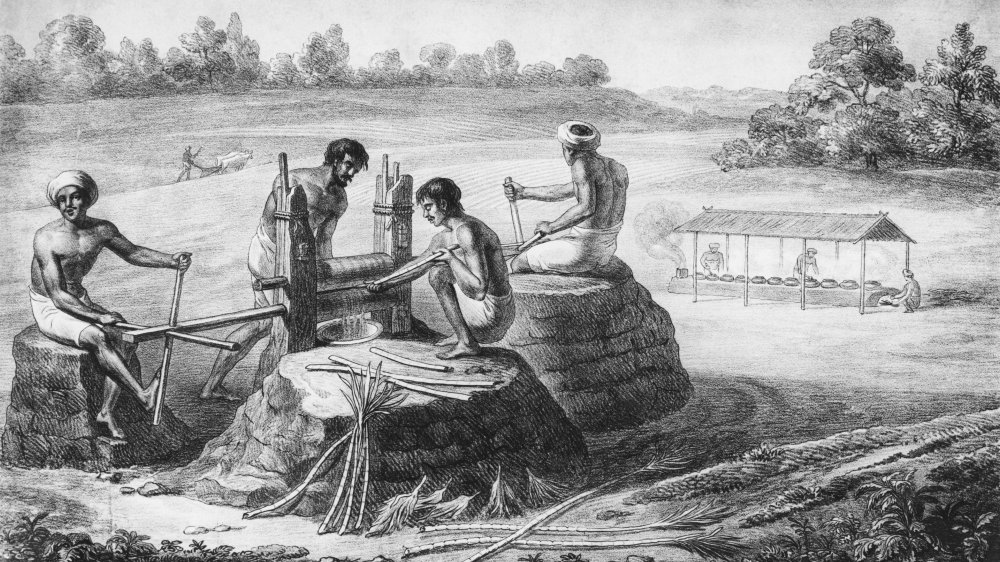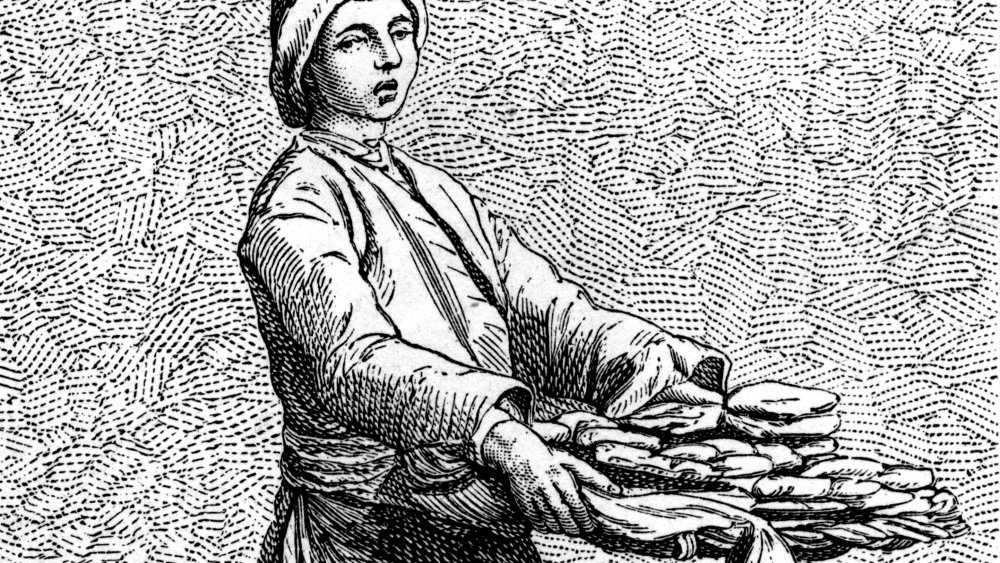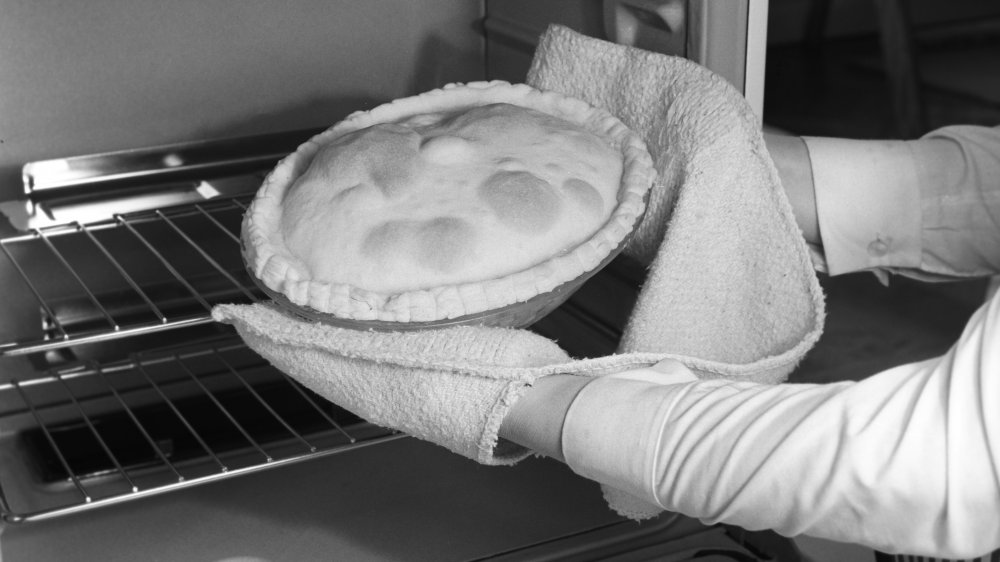The Long History Of Pie Explained
Almost every culture around the world has their own variation of a pie, whether it's handheld or baked in a pan. Historically, pies have been favored not only for their delicious flavors but their ability to preserve their fillings for extended periods of time. This was especially useful not only during the winter but for long sea voyages as well.
In some places, pie underwent various transformations in public opinion, running the gamut from being praised to being considered deadly. But ultimately, pie has come out on top and is often brought out as a favorite treat during holidays.
The very first pies were primarily filled with meat, more often than not a type of bird. But before long, pies had conquered every flavor from savory to sweet. They now come in every imaginable shape and size and have transformed in every culture that they've come into contact with, creating a worldwide range of pies that is changing and coming up with new combinations of flavors every day. This is the long history of pie explained.
So what defines a pie?
A pie is considered to be any sort of pastry shell that has a filling, either meat or sweet, and is covered with a top crust. The top crust is an essential component in traditional pies, for according to Everything Pies, without the top crust, the pastry simply becomes a tart. While a tart may be considered a subset of a pie, most American pies would be considered tarts in England. This discrepancy emerged when pies transformed in their travels to America.
According to the Online Etymology Dictionary, the word "pie" started being used in Medieval Latin around 1300. It's likely related to "pia," meaning "pastry," and is also believed to be connected with the word "pica," which refers to magpies. This connection is thought to be because of the birds' habit of collecting random objects, often like the ingredients that went into pies.
While purists will maintain strict definitions of what counts as a pie or not, almost every culture has a version of a pie, especially ones that are handheld and portable.
Pies around the world
Rightly so, pies have proliferated around the world. While the form may vary across cultures, there seems to be a consistent urge across the globe to fill pastry shells with some sort of savory or sweet filling.
Hand pies are especially prolific, because who wouldn't want a pie that's portable? According to The Takeout, while most hand pies have a semilunar shape, they can be found in all shapes and sizes around the world. Most hand pies are smaller versions of traditional meat pies, but no two are entirely alike. Empanadas and Jamaican patties are arguably the most popular hand pies in the world, but spanakopitas and samosas come in at a close second.
Bastilla, also known as pastilla, is an example of a Moroccan meat pie that brings together the two ends of the pie spectrum, sweet and savory, into a rich blend of poultry, cinnamon, almonds, and sugar. Even pizza masquerades as a pie. But no matter where one travels, pies have surely gotten there first.
Hieroglyphic pie recipes
The earliest known dish resembling a pie comes from the Neolithic period in ancient Egypt, as far back as between roughly 9500 BCE and 2000 BCE. According to the BBC, one example of an ancient Egyptian pie was made out of barley, oats, rye, or wheat and filled with honey. The crust is thought to have been rather dense, and since the crusts of some of the early pies weren't meant to be eaten, it's possible that this crust was meant to hold the filling rather than be eaten itself, similar to a bread bowl. According to What's Cooking America, drawings of pies that used fruits and honey can also be found on the walls of the tomb of Ramses II, who ruled from 1304 to 1237 BCE.
Ancient Egyptians also made classic meat pies as well, with a chicken pie recipe being found carved in hieroglyphs on a tablet. The first recorded use of yeast occurred around roughly 2600 BCE, so it's likely that they were making bread-filled pastries around the same time.
Ancient Egyptian pie evolved into modern-day feteer meshaltet, which translates to "cushion-like pie." Feteer meshaltet is thought to have appeared in a semilunar form at one point as well, and it's believed that the semilunar feteer meshaltet traveled to France, where it transformed into the croissant.
Pies for all of history
From ancient Egypt, pies made their way into ancient Greece by the fifth century BCE. According to Visit Greece, pies were part of the everyday diet of ancient Greeks. And every city and village, whether on the mainland or on an island, has their own version of a pie, with different fillings, sizes, and shapes. According to Cycladia, the Northwestern region of Epirus is the most famous region for Greek pies, likely due to its high population of sheep, which produce a wide variety of cheese, and its plethora of herbs and vegetation. Spanakopita is likely the most famous Greek pie, known for its savory spinach and cheese layers.
The Greek poet Philoxenus writes in his poem "The Banquet" of the hosts of a party serving a pastry made with honey and milk that was baked like a pie. Pies are even mentioned in the plays of Aristophanes, with multiple descriptions of small pastries filled with fruit.
The Romans took the concept from the Greeks and made their pastry shells specifically for encasing and preserving the taste of the filling, rather than to be eaten. It was this version of the pie that made its way through Europe and to Britain.
Pies get medieval
In medieval Britain, pies were primarily filled with meat, and the pastry shells weren't necessarily eaten, like in Rome. The biggest appeal of pies was their ability to conserve space and preserve food for a longer time, especially on long sea voyages. These pies also had significantly more crust than filling and were known as "pyes."
According to Slate, the pie crust was solely functional and was intended to be a hard shell that had to be broken open to get at the delicious filling inside. The crust was made to be incredibly thick so that it was able to withstand being baked over a fire for several hours. And funnily enough, the pie crusts themselves were referred to as "cofyns," which just means "box." This especially emphasizes the pie's ability to store food, since the thick crust also helped keep food fresh for longer.
During this time, the most common filling was crow, and it's rumored that the feet were used as handles. Birds in general were often used as filling, and songbirds especially were considered a delicacy. But according to Pie: A Global History by Janet Clarkson, it's not clear exactly what the recipes for medieval pie crusts were. Medieval cookbooks weren't intended to be instruction manuals and were instead more for those who were tasked with provisioning the kitchen, rather than the cooks themselves. And since pies were so commonplace, almost every cook knew how to make the crust in their sleep.
Breaking out of the pie shell
Medieval pies sometimes included dinner and a show. Known as animated pies, a large crust would be baked over a wooden scaffolding with a hole in the bottom, from which the cook would afterward seal in live birds and a cooked pie. This way, when the top crust was cut open, the live birds would fly out of the outer pie. This custom is still referenced today in the nursery rhyme "Sing a Song of Sixpence." Live birds weren't the only things that burst out of pies. According to What's Cooking America, other small animals, such as turtles, rabbits, and frogs, were also frequently incorporated.
Sometimes, people would also pop out for entertainment. One such person was Jeffrey Hudson, who was known for his small stature, reportedly standing only 18 inches tall at age seven. According to The Vintage News, when Hudson was seven, he was presented to King Charles I and Queen Henrietta Maria in London, bursting through the crust of a pie dressed in knight's armor. Queen Henrietta was so amused by Hudson's small stature that she took him on as her court dwarf.
While there were some versions of sweet pies, in medieval Britain, they were distinguished from meat pies as tarts. And since sugar was expensive and rare, it wasn't commonly used as an ingredient, so medieval sweet pies might not be considered sweet to a modern palette.
The queen always tries first
While Elizabeth I isn't necessarily remembered for her role in the legacy of pie, she's actually involved in the story of what's thought to be the world's first cherry pie. According to the BBC, the first cherry pie was reportedly baked for Elizabeth, although no one knows whether or not she enjoyed it.
During the 16th century, pies also continued the tradition of having appearances in plays. A pie plays a pivotal role in William Shakespeare's Titus Andronicus, becoming a literal coffin for Chiron and Demetrius after they brutalize Titus' children. Titus not only kills Chiron and Demetrius and bakes them into a pie, but he goes on to serve that pie to their mother before murdering her as well.
Pies were also a popular snack for people in the upper classes to eat while watching the plays of Shakespeare. According to The Star, those who sat in the gallery often enjoyed meat pies in addition to crabs and dried figs. People in lower classes who watched from the yard snacked on oysters instead.
Pies travel the Atlantic
As the British invaded and colonized North America, they brought pies along with them. With the different ingredients available across the Atlantic, American pies began to deviate from traditional British recipes.
While the popularity of pies wouldn't explode until the 1800s, colonists often made pies in order to preserve the foods that were used for filling, which would keep during the winter months. According to Time Magazine, despite the fact that apple pie is considered to be quintessentially American, even that came over from England. And until sugar became included in the recipe, it was a far cry from the sweet treat known today.
Mark Twain, also known as Samuel Clemens, was reportedly a big fan of pies, and when he visited Europe, he apparently disparaged the food he encountered, longing instead for the many different kinds of pie to be found back home in the United States.
According to Slate, it was during their travel to America that the difference between tarts and pies became lost to the Americans. It was also around this time that sweet pies began to be more popular. With the establishment of sugar colonies in the Caribbean, sugar became much more common than it had previously been.
The rise of sweet pies
During their occupation and colonization of the Caribbean, the British established hundreds of sugar colonies that were kept running by the enslaved people kidnapped from Africa. On most of the islands, upwards of 80 percent of the population was enslaved.
The spread of sugar plantations led to the proliferation of sugar across Europe and North America, demonstrative in the rise of sweet pies. According to Pie: A Global History by Janet Clarkson, while fruit wasn't entirely absent from pie recipes before the inclusion of sugar, it was rarely the primary ingredient.
By the Victorian era, mince pies, made of an assortment of dried fruits and spices, were also a common sugary treat, and soon, "mincemeat" didn't even have to include meat. And recipe books began including meat-free versions alongside traditional meat pie recipes, allowing for the proliferation of hundreds of different types of pies. With the spread of dairy and eggs, cream pies also rose in popularity alongside fruit pies.
The criticism of pies
As pie became more popular, it also came under attack in the mid-1800s. According to the Los Angeles Times, Harper's Magazine published an attack on pies in 1866, which hyperbolically claimed that, "Pie in countless varieties waits upon us through life. Pie kills us finally." Claiming that the dough of pie crusts was indigestible, dietary reformers continually tried to steer people away from eating pies.
According to The Oxford Companion to American Food and Drink, dietary reformers claimed to be interested in the science of nutrition, but a lot of their attacks seemed to be geared toward immigrants and low-income people. Claiming that if people changed what they ate, then the American spirit wouldn't be weighed down by so much dough, people like Sarah Tyson Rore, food editor of the Ladies' Home Journal, made sure to frequently warn people about how pies took too much energy to digest.
The Century Cookbook, published in 1895, decided to include the comment that, "The American pie is perhaps the most ridiculed of dishes. [...] The mince pie, probably the most indigestible of all, is the one universally accepted as a treat, and seldom refused by the scoffer." According to Smithsonian Magazine, some even believed that eating pie was a cause of divorce, like alcoholism.
But with the outbreak of World War I, eating pie became a patriotic activity. Pies became a symbol of that which soldiers missed while they were off fighting in foreign countries. This association with patriotism would continue.
The alternating popularity of pie
According to Slate, during the Great Depression, Ritz crackers began including recipes for "mock apple pie" on the backs of their boxes. Made with the times in mind, the recipe suggested soaking the crackers in vanilla, lemon, and cinnamon to be used instead of real apple filling, since apples were in short supply and too expensive to indulge in.
By the mid-20th century, however, the popularity of pies began to rise again as canned fruit and instant pudding mixes made it easier to make filling. Ready-made pie crusts also drastically simplified the pie-making process, and with the spread of home refrigeration, chilled pie recipes also became increasingly common. But, according to The Oxford Companion to American Food and Drink, simultaneously, the amount of pies being made started to dip as a result of urbanization and industrialization. As more and more women joined the workforce, the act of making a pie every week was too laborious an activity, so it started to become more of an occasional undertaking for special occasions.
All the same, pies continued to persevere as a symbol of America. According to Smithsonian Magazine, when Soviet premier Nikita Khrushchev went to New York City in 1960, someone sent an apple pie to his Park Avenue address. The American pie was meant to represent all the layers that America had, while "the Communist pie is nothing but crust."
Pies endure
Today, pies are considered a quintessential dessert for some holidays and remain a savory meal for any day of the year. Pies also continue to evolve as people come up with hundreds of types of crusts and fillings. After being called "an American evil" and an "unmoral food [sic]" by Kate Masterson in The New York Times in 1902, pies have remained a classic of not only American cuisine but of cuisines around the world. The pie-in-the-face joke even endures as physical comedy. Pies have even become punnily associated with Pi Day, celebrated on March 14 due to its resemblance to the mathematical number.
But it seems that the exact definition of a pie still eludes us. According to Slate, Emily Elsen, founder of the pie shop "Four and Twenty Blackbirds," her European customers call her pies "cakes," and the debate of pies vs. tarts seems endless.
According to Smithsonian Magazine, the phrase "as American as apple pie" didn't appear until 1924, when it was used in an advertisement for men's suits. But no one culture has a monopoly on pies. Pies have transformed in every culture they've engaged with, and even if no one can determine exactly what counts as a pie, few will pass up a free slice.
